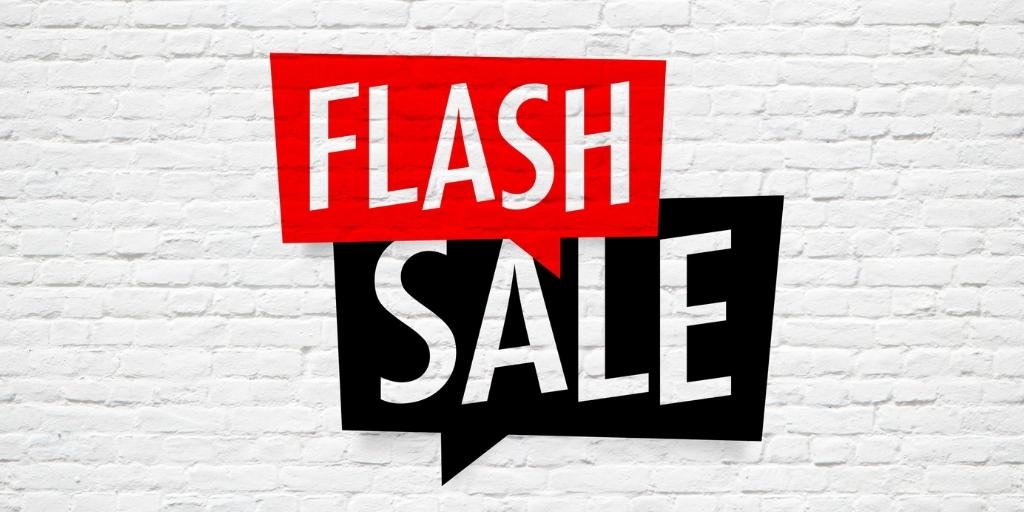
The Ultimate Guide to Running Successful Flash Sales – Part 1
Table of Contents
- What Is a Flash Sale?
- How Flash Sales Benefit You
- Is a Flash Sale Right for Your Business?
- How to Prepare for a Successful Flash Sale (and Avoid a Flop)
- 1) Determine Your Goal, Product, and Targets (Why, What, and Whom)
- 2) Figure Out When to Run Your Flash Sale
- 3) Set the Length of Your Flash Sale
- 4) Settle on the Discounts You’ll Be Offering
- 5) Promote Your Flash Sale
- 6) Forget about Other Companies & Check Your Stats
- 7) Double-Check Your Inventory, Website, and Shipping Capabilities
- Final Thoughts: Preparing for Successful Flash Sales
Have you ever joined the stampede through the shopping aisles to hunt down the discounted video game console your kid just had to have? If so, it likely happened on Black Friday, one of the biggest shopping days of the year. With it being that time of year again, it’s worth discussing how e-commerce businesses can entice customers by learning to run successful flash sales.
Here’s why…
Great sales cause people to do crazy things—camp out overnight outside stores, scavenge last-minute coupons, and plan shopping trips with military precision. But this phenomenon isn’t exclusive to brick-and-mortar establishments. Even the draw of online deals can have people nearly breaking their fingers in a rush to add items to their virtual cart. For customers, it’s a small price to pay for the reward of such deep discounts.
For you, a small or medium-sized business owner, the payoff can be even greater. Successful flash sales can generate a 35% lift in transaction rates, not to mention bring in a horde of new customers to your business.
That said, profits aren’t guaranteed. You have to execute flash sales correctly to reap the benefits. And preparing successful flash sales is exactly what we are showing you to do.
In Part 1 below, we will dive into what flash sales are, how you can benefit from them, and how to prepare for them the right way so you don’t make costly mistakes that could damage your brand reputation.
In Part 2, we will cover executing and marketing a flash sale from start to finish.
What Is a Flash Sale?
When you run a flash sale, you offer deep discounts or other promotions on a limited number of products for a very short time. This type of sale typically runs for 24 to 48 hours but could be as few as 3.
Although the concept has been around for a while, the term “flash sale” is commonly used to refer to deals available from e-commerce stores. That’s because they work particularly well for industries where brands compete to grab the attention of online shoppers.
The most successful flash sales are only available for a limited time to encourage shoppers to make impulse buys. Creating a sense of urgency appeals to the buyer’s emotions rather than giving them a chance to second-guess their first impulse. Buyers feel compelled to buy something they love at first sight before they risk losing it. But they also win because they get products at deep discounts, which they might not be able to purchase otherwise.
Here’s an example of a flash sale offered by Gap Factory. The brand discounted its products by 40% for two days.

Beauty Deals BFF offered 20% off certain packaged Estee Lauder products with free shipping for one day only.

Flash sales can also give away free items or services. Here Toyota of Murray announces a 4-hour flash sale offering free window tinting instead of a discount.
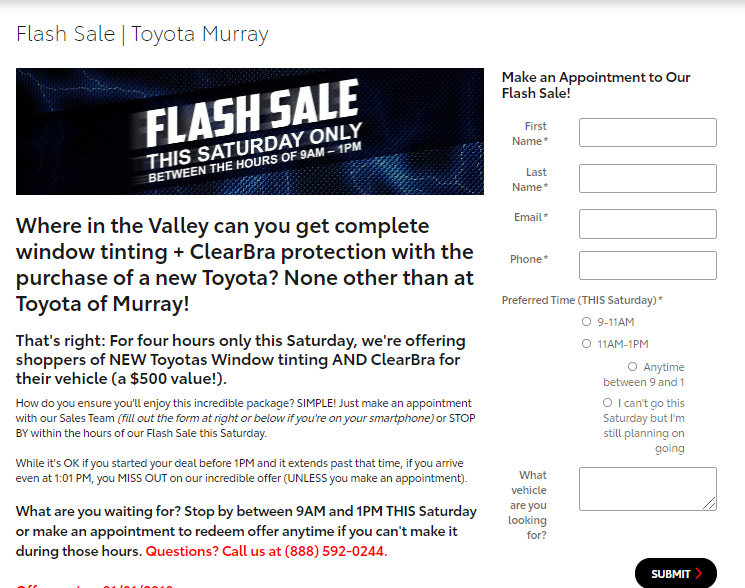
How Flash Sales Benefit You
Today’s consumers are faced with numerous sales from hundreds of companies daily. Flash sales give you a way to stand out from the crowd and deliver a limited-time offer that urges consumers to click and buy (quickly). They cater to consumers who can’t bear to miss a discount, fearing it will never come around again.
This is why successful flash sales can be so lucrative for brands. According to Reuters, businesses that used holiday flash sales grew at least twice as fast as other e-commerce stores during one holiday season.
But here’s the thing—flash sales aren’t suitable for everyone.
Flash sales (with deeper discounts) can cut into your profits, so your goal isn’t to make hefty initial gains. If you are looking for a large burst of revenue in a short period, flash sales may not be the way to go. The true power of successful flash sales is as part of a long-term strategy to build trust with new and current customers and the future revenue it could become.
These long-term gains include the following:
- Brand awareness: Flash sales catch the attention of new consumers who may have never heard of your brand or products.
- New customers: Some of those people who are now exposed to your brand may also become customers.
While many flash sale buyers are in it just for the deep discounts, a percentage can stay connected to your brand (if they love your products) and become repeat loyal customers.
This also hinges on how well you planned and prepared for the flash sale (we will discuss this later in the article).
- Current customers: Want to reactivate current customers? Maybe you have some customers who haven’t engaged with your brand in a while due to consumer overload.
A flash sale can be just what they need to get reengaged. It can also improve brand loyalty, for example, by alerting email subscribers to upcoming discounts and rewarding them with bargains.
Aside from business building, successful flash sales can also help you get rid of excess inventory (end of season, old items, etc.) so you can make room for new, top-selling items.
If you judge that you stand to gain more than you lose by taking the risk, you can improve your chances of success by following the guidelines we outline below.
Is a Flash Sale Right for Your Business?
To answer this question, determine WHY you want to run the flash sale. What is your overall goal?
- Get new customers
- Retarget existing customers and build brand loyalty
- Temporarily boost revenue
- Sell off excess inventory and low-demand items
- Gain website traffic
- Draw attention to upsells and cross-sells
- Increase brand awareness
If any of these align with your own goals, a flash sale could work well for you.
Having said that, think about your long-term plan for these sales.
If a boost in your short-term revenue from offering deep discounts isn’t your primary goal, these sales could hurt you if they don’t result in any new customers OR they turn customers away due to unpreparedness. In addition, because so many brands are running flash sales now, your customers may not even notice your sale in the sea of others.
So, the key here is to plan the right way to ensure an effective sale. Below we will go through the important steps to planning a successful flash sale. In Part 2 of this series, we will go into how to execute one from start to finish and market it for maximum results.
How to Prepare for a Successful Flash Sale (and Avoid a Flop)
Preparing for a flash sale requires a little creativity. It also requires an understanding of what your audience wants so that you can avoid common mistakes. Here are some of the most important steps:
1) Determine Your Goal, Product, and Targets (Why, What, and Whom)
Before you start your flash sale, get clear on your campaign goal. This is your WHY.
Sure, it would be great to increase website traffic, get new customers, and retarget current ones all at the same time. Of course, it might happen anyway, but they are too many goals to plan for. Focus on one specific purpose, so all your targeting, marketing, and preparation align.
Some common goals to choose from include the following:
- Converting prospects into customers and collecting contact information
- Getting rid of unsold inventory
- Improving brand awareness
- Developing goodwill among customers to nurture loyalty
Once you determine your goal, choose WHAT product(s) to sell and WHOM to target.
First, decide if you want to target new or existing customers. That would depend on whether your goal is to build your customer base or reengage existing customers, for example.
Even though you may accomplish both anyway, you still have to select one because your strategy and product choice depend on your target audience.
Once you decide on your target, choose your product. Let’s dive into this a little deeper and discuss which products to select depending on that decision.
Targeting New Customers
- Don’t sell excess inventory: It may not be a good idea to sell excess inventory if you are trying to attract new customers. “Old” stock may appeal more to the people who are already familiar with your brand. Consider moving out current inventory only to make room for the next season.
- Go with what you know: Promote your top-selling item in the flash sale—the one you know most of your customers love. Don’t test out new products when targeting new customers.
- Undercut the competition: Steal customers from your competitors by offering related products at a deeper discount. This may cut into your profits, but if you gain more customers, you’ll enjoy the benefit in the long term.
Targeting Existing Customers
- Make it personal: Choose a product based on how you can personalize the marketing…
We talked about personalization marketing in another article and how offering products relevant to your customers increases conversions.
Whatever product you put on sale, create segments for your newsletter to target only the people who would be interested. Instead of just launching a random deal, focus on product interest and send out the email to a segment that would be more likely to buy (previous customers who bought related products).
Carparts.com sends personalized emails to customers promoting their flash sales, offering discounted parts. They do this based on the target’s buying history. In the example below, they only promoted car parts for a 2010 Mazda 3 based on the recipient's model.
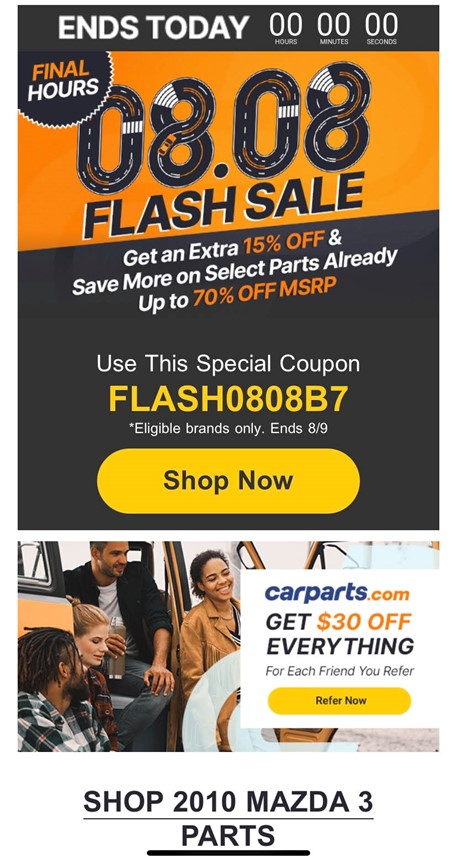
- Highlight best sellers: Like new customers, current customers will also be interested in your best sellers.
Tip: If you are running a short promotion (less than 12 hours) or don’t sell many products, consider using a best seller, a product proven to perform well.
- Promote excess inventory: Trying to get rid of excess inventory? Sell to existing customers who are already familiar with your brand.
2) Figure Out When to Run Your Flash Sale
Flash sales work best when they are run only occasionally. That way, they continue to feel special. Otherwise, people will take them for granted. So, it’s better to tie them to holidays and other events.
There are a few other reasons to use flash sales sparingly. For starters, they can damage your reputation if they go wrong. Plus, you might not want to become known as a discount store. (That said, some large chain stores and online retailers such as Amazon, Target, and Home Depot do offer daily deals on a few select items. However, this approach is likely based on data in each case.)
Here are some recommended times for successful flash sales:
- Before the holidays: The holiday season is approaching, so running a few holiday flash sales (including Black Friday and Cyber Monday) could result in some nice gains.
Amazon offers early Black Friday flash sales, such as these products that are available at 40 and 30% off. Note the green counter showing the hours left until the deal ends.
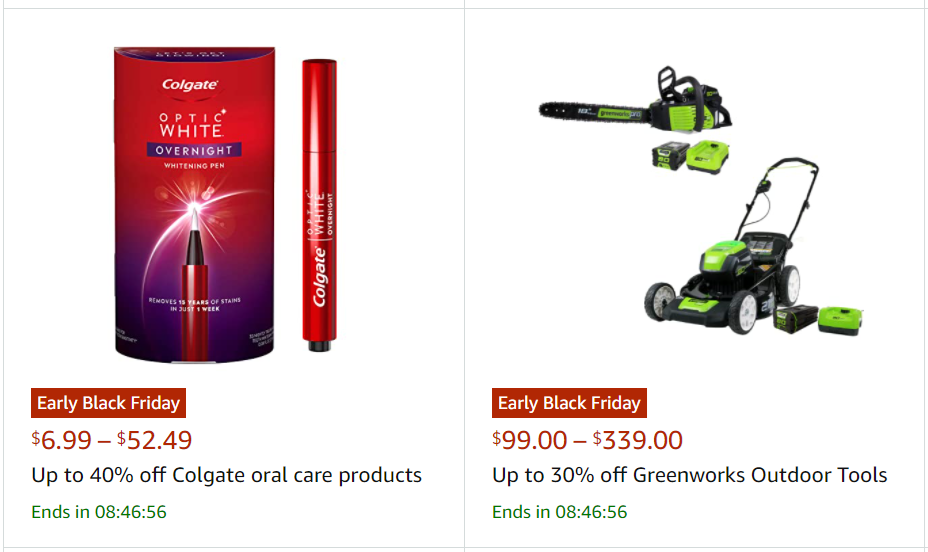
Here’s a good tactic to prepare for holiday flash sales: Run them targeting new customers early in the holiday season (October). This way, you will increase your customer base in time for the holiday rush.
Every holiday is a prime opportunity to run 24-hour flash sales. You’ve seen the holiday email promos, right? Father’s/Mother’s Day, Labor Day, Memorial Day, July 4th, and of course, the holiday and Christmas season are great opportunities to boost sales and bring in customers.
- After the holidays: Running sales after the holidays is an excellent way to recapture losses from higher-than-normal returns—of unwanted gifts. It can also capture some revenue from people who received store credits from returns and gift cards.
- National celebration days: There is a day marking and marketing just about every industry, profession, and interest. Consult the National Day Calendar to time your flash sale to coincide with the one that matches your product or service.
In the ad below, Target’s flash sale offers 25% off M&M’s to coincide with National Candy Day.
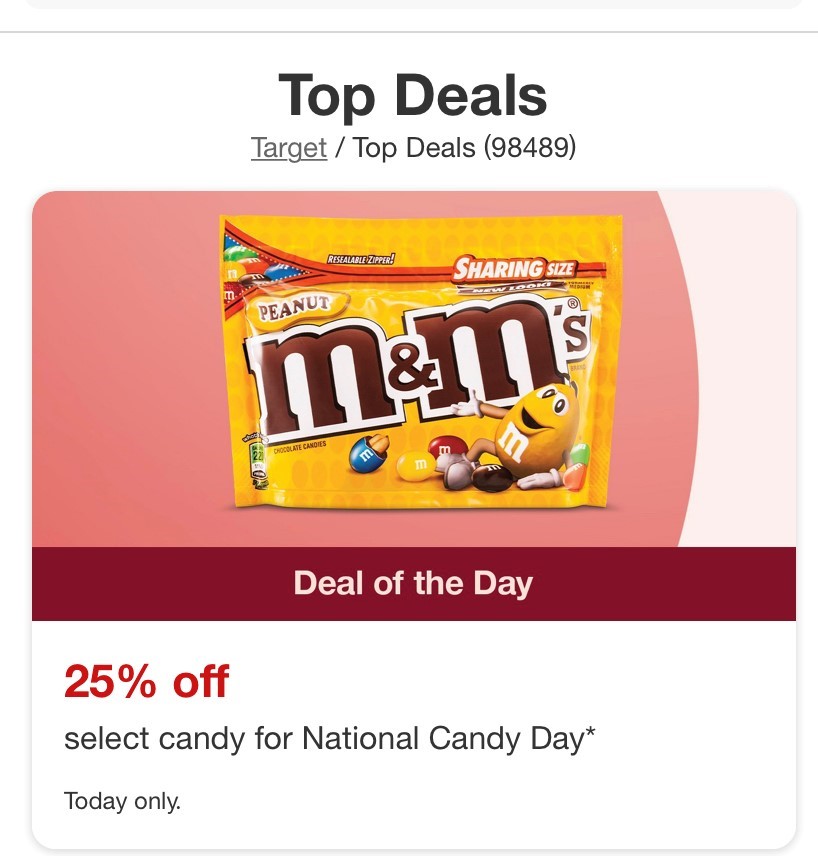
3) Set the Length of Your Flash Sale
As mentioned before, typical flash sales run for 24 to 48 hours. Some run for a couple of days to a week, and others run for a couple of hours. It all depends on what your audience prefers.
The shorter the flash sale, the greater the sense of urgency it creates for the buyer. Research shows that 3-hour flash sales have 14% transaction rates (the highest tested). In addition, sending flash sale emails after 3 p.m. into the evening results in a 9% higher open rate and 23% higher transaction rate than sending them around lunchtime (midday).
Land’s End frequently sends out email notices in the mid-afternoon for deals that end in just a few hours. The email notification below was received at around 3:30 p.m., advertising a 50% discount on sweaters that ended the same night.

Here’s the thing, though—the risk of running 3-hour flash sales is that you may not have enough time to capture attention.
What if your customer is in a 3-hour meeting, at the spa, or making dinner? Three hours doesn’t leave a lot of room for engagement. Typically, successful flash sales run for 24 hours at least. But, if you want to try it, test out a 3-hour deal and see how it does.
Alaska Airlines, for example, sends out monthly emails involving flash sales at various times. The company could be testing flash sale time durations, or the brand knows that different durations perform better on other days since recipients receive them anytime between 11 a.m. to 10 p.m. the day of the sale.
The point here is that whether you are launching your first flash sale or you are a veteran, be strategic with the days and time duration and keep track of your results, letting the data inform your future decisions.
4) Settle on the Discounts You’ll Be Offering
It’s unlikely you will see a super successful flash sale that offers a measly 10% discount. Successful flash sales usually go for deep discounts—such as 40%, 50%, 60%, or more.
Think about this…
Why is it that you only see the crazy discounts on Black Friday and some holidays? Because otherwise, Black Friday wouldn’t be so popular with consumers. There would be no reason to fight the crowds on that one day if they could get the same discount any other time of the year.
Offer a discount you wouldn’t usually offer, so consumers know they need to take advantage of it right away—or else they will miss out.
Another option is to advertise a much lower product price. Some retailers slash their products drastically, virtually giving away select items. This might seem unwise. However, this tactic can work as a long-term strategy, for example, to expand the customer base by collecting contact information or a loss leader to get people to sign long-term contracts. It also may act as a gateway, encouraging customers to look for other products.
In the example below, T-Mobile offers heavily discounted phones in return for the consumer signing up for a one to two-year contract. While this may not be a true flash sale, it shows that giving away or heavily discounting even expensive products can provide the long-term benefit of recurring income.
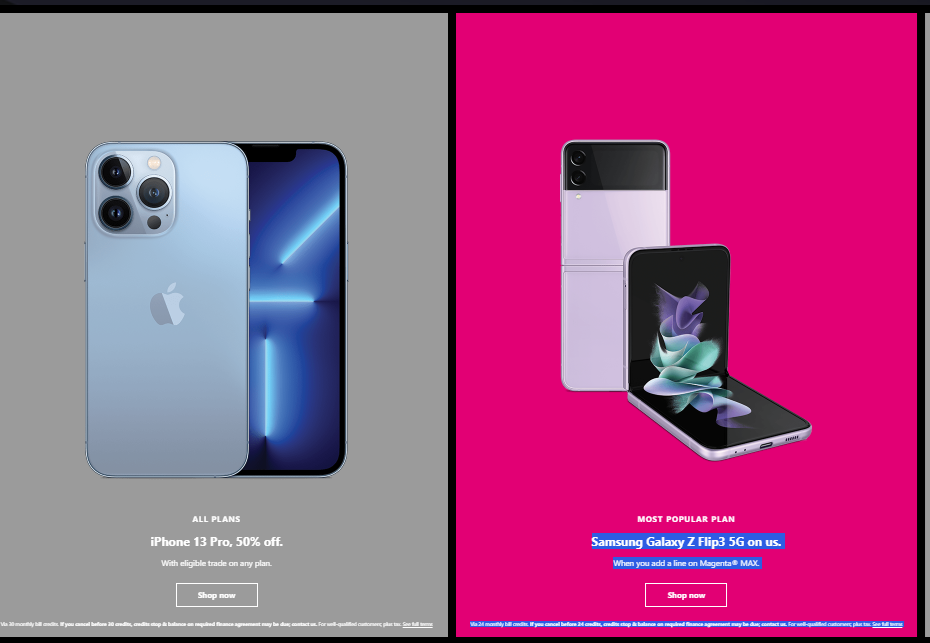
In addition to offering discounts, you could also consider offering other benefits, such as free shipping and delivery or tempting bonus gifts that complement the product you are promoting.
Remember that the goal behind flash sales isn’t just to get some quick revenue. You may not even make as much as you would like.
The ultimate goal is whatever you choose (brand awareness, traffic, attract new customers, re-engage current customers), and the gains will be realized long after the flash sale is over.
5) Promote Your Flash Sale
There are multiple ways to promote flash sales, and each has its strengths, depending on where your target audience is in the funnel and how long the sale will last.
- Emails: Emails are used for promoting flash sales to existing customers and others who have opted in to hear from you. They also offer one of the highest engagement rates.
- Text messages: Flash sales are over quickly by definition, so you want people to read your ad as soon as possible. You can send out notifications via SMS messages and have people receive text alerts instantly through their phones or smartwatches.
- Social media platforms: Increase brand awareness among new prospects and sell to existing customers by advertising on social media channels like Facebook, Instagram, Pinterest, and Twitter.
Below, Macy’s used Facebook Stories to announce early access for Black Friday deals.
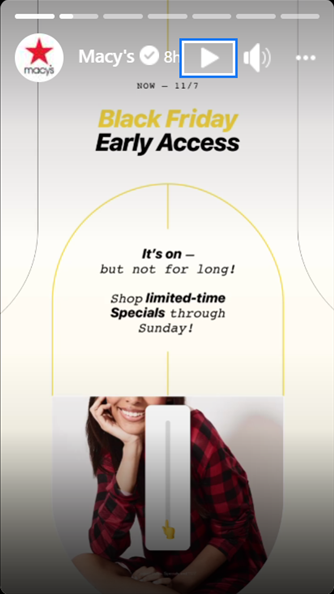
- Paid ads: Paid ads on Google will place you near the top of the results for relevant searches. This is great for reaching new customers who are actively looking for products like the ones you offer.
We’ll go into more depth on using different marketing tactics to your best advantage in Part 2.
6) Forget about Other Companies & Check Your Stats
Now you know what some other companies do, but what does your audience prefer? It could be a stark difference compared to what global statistics and other companies tell you.
Ultimately, your data will tell you when to run your flash sale.
- Check your analytics data to see which days of the week (and what times) your sales are the highest.
- Check your email data to determine what send times your email open rates are the highest. If you don’t know, run some tests, and send emails at different times to prepare for the flash sale.
- Split test the same email sent at various times to see which one performed the best.
- Run a couple of mini flash sales early in the season like already mentioned and use two different sale durations—notice which one performed better.
That’s not to suggest running multiple flash sales, one after the other, day after day. You don’t want your customers to think that your sales aren’t genuine because your prices are always that low.
Also, you may upset customers who pay higher prices if you keep slashing your prices too often. Having said that, since the holiday season is approaching, consumers are prepared for massive sales, so it won’t seem out of the ordinary when you send a few their way.
At this point, you may be asking yourself…
“What if I’m new to this and don’t have any data yet?”
If this is your first flash sale, start with 24 hours, send emails after 3 p.m., and record your results. Take notice of email open rates/times, sales, and clicks. Use this data to inform your next flash sale.
7) Double-Check Your Inventory, Website, and Shipping Capabilities
A flash sale can be hugely rewarding—or tremendously damaging. This is why preparation is vital, especially when it comes to shipping and inventory.
If you are running your first flash sale, we recommend you consult with someone who has experience running these types of deals. Here are some preparation steps to keep in mind:
- Do you have enough inventory to satisfy volume? If you have run flash sales before, you will have a better idea of the demand. If not, get some figures from an experienced marketer on the typical percentage increases for your industry. This way, you can be prepared with the inventory. Selling out during a flash sale is a no-no.
- How long will it take your customers to receive their products? If you are importing internationally and your shipping times range from 2-4 weeks, running a flash sale may not be such a good idea, especially if you are targeting new customers. If so, be clear on your product and checkout pages about how long it will take the product to arrive. People expect quick shipping. Anything less, and they may fault the brand.
- Additional traffic = website crash. Talk to your hosting company and make sure your site can handle the additional traffic surge.
Final Thoughts: Preparing for Successful Flash Sales
Running successful flash sales can boost sales in the short run. However, such a promotion is more effective as a long-term strategy in raising brand awareness, attracting new customers, re-engaging existing ones, or collecting contact information.
Here’s a recap of the critical groundwork to ensure your flash sale hits the clearly defined goal you have set:
- Determine your goals
- Choose a product and a target audience
- Select the ideal day to run your sale
- Select the perfect time to run your sale
- Select a discount
- Make sure you have enough inventory to satisfy volume
- Tighten up your shipping
- Prepare for increased traffic on your website
- Review your stats
In Part 2, we will cover setting up successful flash sales and marketing them for maximum results. Want to find out how well your marketing is working now before you launch your first (or next) flash sale? Request a FREE audit today!

